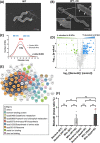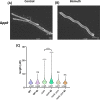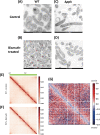Bacterial Membrane Vesicles as a Novel Strategy for Extrusion of Antimicrobial Bismuth Drug in Helicobacter pylori
- PMID: 36154274
- PMCID: PMC9601102
- DOI: 10.1128/mbio.01633-22
Bacterial Membrane Vesicles as a Novel Strategy for Extrusion of Antimicrobial Bismuth Drug in Helicobacter pylori
Abstract
Bacterial antibiotic resistance is a major threat to human health. A combination of antibiotics with metals is among the proposed alternative treatments. Only one such combination is successfully used in clinics; it associates antibiotics with the metal bismuth to treat infections by Helicobacter pylori. This bacterial pathogen colonizes the human stomach and is associated with gastric cancer, killing 800,000 individuals yearly. The effect of bismuth in H. pylori treatment is not well understood in particular for sublethal doses such as those measured in the plasma of treated patients. We addressed this question and observed that bismuth induces the formation of homogeneously sized membrane vesicles (MVs) with unique protein cargo content enriched in bismuth-binding proteins, as shown by quantitative proteomics. Purified MVs of bismuth-exposed bacteria were strongly enriched in bismuth as measured by inductively coupled plasma optical emission spectrometry (ICP-OES), unlike bacterial cells from which they originate. Thus, our results revealed a novel function of MVs in bismuth detoxification, where secreted MVs act as tool to discard bismuth from the bacteria. Bismuth also induces the formation of intracellular polyphosphate granules that are associated with changes in nucleoid structure. Nucleoid compaction in response to bismuth was established by immunogold electron microscopy and refined by the first chromosome conformation capture (Hi-C) analysis of H. pylori. Our results reveal that even low doses of bismuth induce profound changes in H. pylori physiology and highlight a novel defense mechanism that involves MV-mediated bismuth extrusion from the bacteria and a probable local DNA protective response where polyphosphate granules are associated with nucleoid compaction. IMPORTANCE Bacterial resistance to antibiotics is a major threat to human health. Treatments combining antibiotics with metals were proposed to circumvent this hurdle. Only one such combination is successfully used in clinics associating antibiotics with the metal bismuth to treat infections by the human pathogen Helicobacter pylori. H. pylori causes 800,000 deaths by gastric cancer yearly. How bismuth impacts H. pylori and its response to this toxic metal were ill defined. We discovered that upon bismuth exposure, H. pylori secretes membrane vesicles that are enriched in bismuth. Bismuth also induces the formation of intracellular polyphosphate granules associated with compaction of the chromosome. Upon bismuth exposure, H. pylori displays both defense and protection mechanisms, with bismuth extrusion by vesicles and shielding of the chromosome.
Keywords: Helicobacter pylori; Hi-C; antibiotic resistance; bismuth; chromosome conformation capture; membrane vesicles; polyphosphate granules.
Conflict of interest statement
The authors declare no conflict of interest.
Figures






Similar articles
-
Nickel, an essential virulence determinant of Helicobacter pylori: Transport and trafficking pathways and their targeting by bismuth.Adv Microb Physiol. 2022;80:1-33. doi: 10.1016/bs.ampbs.2022.01.001. Epub 2022 Feb 18. Adv Microb Physiol. 2022. PMID: 35489790 Review.
-
Integrative proteomic and metabolomic analyses reveal the mechanism by which bismuth enables Helicobacter pylori eradication.Helicobacter. 2021 Dec;26(6):e12846. doi: 10.1111/hel.12846. Epub 2021 Aug 20. Helicobacter. 2021. PMID: 34414638
-
Novel and Effective Therapeutic Regimens for Helicobacter pylori in an Era of Increasing Antibiotic Resistance.Front Cell Infect Microbiol. 2017 May 5;7:168. doi: 10.3389/fcimb.2017.00168. eCollection 2017. Front Cell Infect Microbiol. 2017. PMID: 28529929 Free PMC article. Review.
-
Development of Helicobacter pylori treatment: How do we manage antimicrobial resistance?World J Gastroenterol. 2019 Apr 28;25(16):1907-1912. doi: 10.3748/wjg.v25.i16.1907. World J Gastroenterol. 2019. PMID: 31086459 Free PMC article. Review.
-
The actions of bismuth in the treatment of Helicobacter pylori infections: an update.Metallomics. 2012 Mar;4(3):239-43. doi: 10.1039/c2mt00180b. Epub 2012 Feb 23. Metallomics. 2012. PMID: 22358069 Review.
Cited by
-
Time- and dose-dependent activation of the NLRP3 and MyD88/NF-κB pathways by Trueperella pyogenes membrane vesicles in bovine endometrial epithelial cells.Vet Res. 2025 Jul 21;56(1):155. doi: 10.1186/s13567-025-01587-9. Vet Res. 2025. PMID: 40691648 Free PMC article.
-
Extent of Virulence and Antibiotic Resistance Genes in Helicobacter pylori and Campylobacteria.Curr Microbiol. 2024 Apr 23;81(6):154. doi: 10.1007/s00284-024-03653-5. Curr Microbiol. 2024. PMID: 38652129
-
Biological Activities of Bismuth Compounds: An Overview of the New Findings and the Old Challenges Not Yet Overcome.Molecules. 2023 Aug 7;28(15):5921. doi: 10.3390/molecules28155921. Molecules. 2023. PMID: 37570891 Free PMC article. Review.
-
Opportunities for Helicobacter pylori Eradication beyond Conventional Antibiotics.Microorganisms. 2024 Sep 30;12(10):1986. doi: 10.3390/microorganisms12101986. Microorganisms. 2024. PMID: 39458296 Free PMC article. Review.
-
Enhancement Effects and Mechanism Studies of Two Bismuth-Based Materials Assisted by DMSO and Glycerol in GC-Rich PCR.Molecules. 2023 Jun 2;28(11):4515. doi: 10.3390/molecules28114515. Molecules. 2023. PMID: 37298991 Free PMC article.
References
-
- Frei A, Zuegg J, Elliott AG, Baker M, Braese S, Brown C, Chen F, G Dowson C, Dujardin G, Jung N, King AP, Mansour AM, Massi M, Moat J, Mohamed HA, Renfrew AK, Rutledge PJ, Sadler PJ, Todd MH, Willans CE, Wilson JJ, Cooper MA, Blaskovich MAT. 2020. Metal complexes as a promising source for new antibiotics. Chem Sci 11:2627–2639. doi:10.1039/c9sc06460e. - DOI - PMC - PubMed
-
- Tursi A, Franceschi M, Allegretta L, Savarino E, De Bastiani R, Elisei W, Baldassarre G, Ferronato A, Scida S, Miraglia C, Penna A, Licci C, Rizzo GL, Pranzo G, Cassieri C, Brandimarte G, Picchio M, Di Mario F. 2018. Effectiveness and safety of Pylera in patients infected by Helicobacter pylori: a multicenter, retrospective, real life study. Dig Dis 36:264–268. doi:10.1159/000487391. - DOI - PubMed
Publication types
MeSH terms
Substances
LinkOut - more resources
Full Text Sources
Medical
